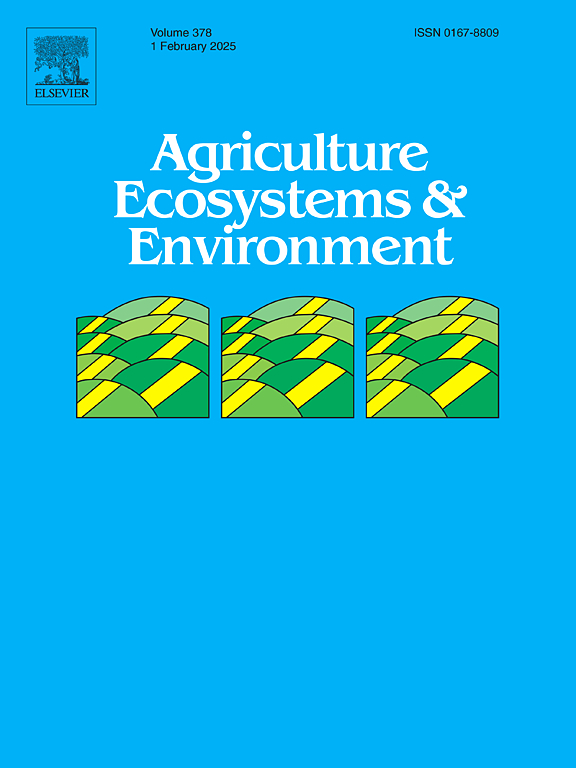Landuse affects the likelihood of soil colonization by a key plant pathogen
IF 6
1区 农林科学
Q1 AGRICULTURE, MULTIDISCIPLINARY
引用次数: 0
Abstract
Fencing and other biosecurity measures can help to reduce the spread of soil-borne pathogens, but are often compromised by weather, animals and insects. Once contaminated soil spreads beyond a farm, neighbouring land can either help or hinder pathogen dispersal based on its susceptibility to colonization. Fusarium wilt of banana, caused by the soil-borne pathogen Fusarium oxysporum f. sp. cubense (Foc), poses a serious threat to global banana production. In the Wet Tropics Region of Queensland, where most of Australia’s bananas are grown, we found that banana production land is mostly bordered by rainforest, grassland, and sugarcane production areas. In soil inoculation experiments using quantitative PCR, we found that Foc was highly likely to colonize banana soils, moderately likely to colonize sugarcane soils, and unlikely to colonize rainforest or grassland soils, suggesting that rainforest and grassland may act as natural barriers against Foc spread. When sterilized soils were inoculated, Foc proliferated to high levels regardless of landuse, indicating that biotic factors underpin the differential response of landuses to Foc colonization. Differences in the extent and likelihood of Foc soil colonization between soils were associated most strongly with the soil fungal and bacterial community composition and fungal:bacterial biomass ratio. Based on our findings, we propose that future work should explore the use of ground covers, soil amendments and other strategies to improve soil suppressiveness to Foc. Together, our findings offer valuable insights for land managers and demonstrate the importance of rainforest and grassland soils in limiting Foc spread across the landscape.
土地利用会影响一种关键植物病原体在土壤中定植的可能性
围栏和其他生物安全措施可以帮助减少土壤传播的病原体的传播,但往往受到天气、动物和昆虫的影响。一旦受污染的土壤扩散到农场以外,邻近的土地就会根据其对定植的易感性来帮助或阻碍病原体的扩散。香蕉枯萎病(Fusarium oxysporum f. sp. cubense, Foc)是一种由土传病原菌引起的香蕉枯萎病,对全球香蕉生产构成严重威胁。在澳大利亚大部分香蕉种植的昆士兰州的湿热带地区,我们发现香蕉生产地大多与雨林、草原和甘蔗生产区接壤。在土壤接种实验中,我们发现Foc极有可能在香蕉土壤中定植,中等可能在甘蔗土壤中定植,而不太可能在雨林或草地土壤中定植,这表明雨林和草地可能是Foc传播的天然屏障。当接种无菌土壤时,无论土地利用方式如何,Foc的增殖水平都很高,这表明生物因素支持了土地利用对Foc定植的差异反应。土壤间Foc定植程度和可能性的差异与土壤真菌和细菌群落组成以及真菌与细菌生物量比的关系最为密切。基于我们的研究结果,我们建议未来的工作应该探索利用地被覆盖、土壤改质和其他策略来提高土壤对Foc的抑制作用。总之,我们的研究结果为土地管理者提供了有价值的见解,并证明了雨林和草地土壤在限制Foc在景观中的传播方面的重要性。
本文章由计算机程序翻译,如有差异,请以英文原文为准。
求助全文
约1分钟内获得全文
求助全文
来源期刊

Agriculture, Ecosystems & Environment
环境科学-环境科学
CiteScore
11.70
自引率
9.10%
发文量
392
审稿时长
26 days
期刊介绍:
Agriculture, Ecosystems and Environment publishes scientific articles dealing with the interface between agroecosystems and the natural environment, specifically how agriculture influences the environment and how changes in that environment impact agroecosystems. Preference is given to papers from experimental and observational research at the field, system or landscape level, from studies that enhance our understanding of processes using data-based biophysical modelling, and papers that bridge scientific disciplines and integrate knowledge. All papers should be placed in an international or wide comparative context.
 求助内容:
求助内容: 应助结果提醒方式:
应助结果提醒方式:


